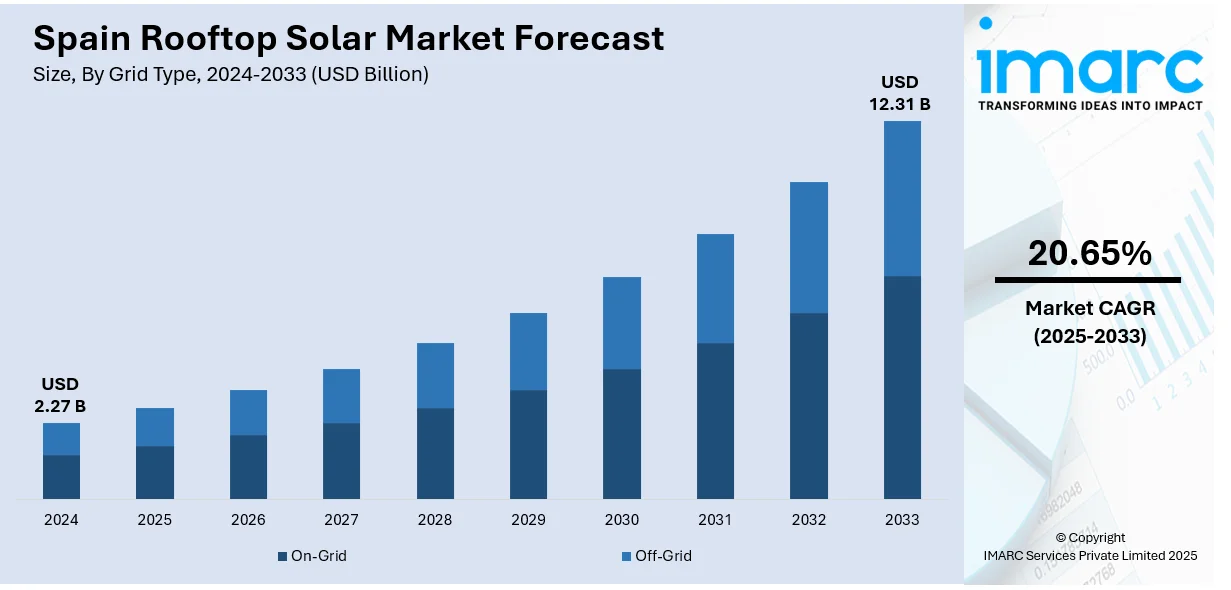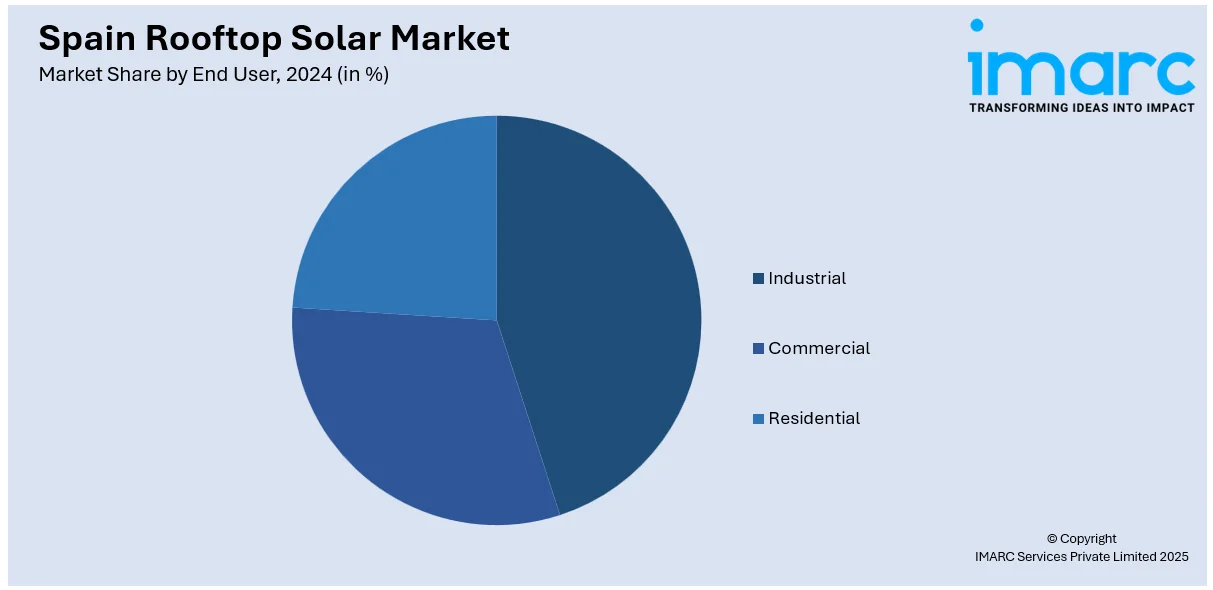
Spain Rooftop Solar Market Size, Share, Trends and Forecast by Grid Type, End User, and Region, 2025-2033
Spain Rooftop Solar Market Overview:
The Spain rooftop solar market size reached USD 2.27 Billion in 2024. Looking forward, IMARC Group expects the market to reach USD 12.31 Billion by 2033, exhibiting a growth rate (CAGR) of 20.65% during 2025-2033. The market is expanding due to favorable government policies, declining solar panel costs, and rising energy independence demand. Net metering, self-consumption incentives, and sustainability goals drive adoption. Increasing residential and commercial installations, along with advancements in solar storage, contribute to market growth amid Spain’s strong solar potential.
|
Report Attribute
|
Key Statistics
|
|---|---|
|
Base Year
|
2024 |
|
Forecast Years
|
2025-2033
|
|
Historical Years
|
2019-2024
|
| Market Size in 2024 | USD 2.27 Billion |
| Market Forecast in 2033 | USD 12.31 Billion |
| Market Growth Rate 2025-2033 | 20.65% |
Spain Rooftop Solar Market Trends:
Rising Self-Consumption and Net Metering Adoption
Spain's rooftop solar sector is growing steadily with self-consumption taking off, pushed by favorable policies including the scrapping of the "sun tax." The self-consumption model allows consumers to produce their own electricity and enjoy excess energy via net metering. In 2024, nearly 51, 306 new residential installations were accounted for, with single-family dwellings in Madrid sustaining more than 70% self-supply, while urban high-rise areas hit about 30%. Increasing grid electricity costs are motivating residences and companies to install rooftop solar panels, cutting their reliance on conventional energy sources. Moreover, the development of battery storage technologies is enhancing self-consumption efficiency, enabling saved excess energy to be utilized later. All these elements are propelling the integration of decentralized energy solutions, further consolidating Spain's movement toward a sustainable and autonomous energy system.

Declining Solar Panel and Installation Costs
The decreasing costs of photovoltaic (PV) technology are driving the expansion of Spain’s rooftop solar market. Solar panel prices have steadily declined due to improved manufacturing efficiency, economies of scale, and increased supplier competition. Streamlined permitting processes and reduced installation costs have further enhanced accessibility for residential and commercial consumers. Government incentives strengthen financial viability, with homeowners benefiting from personal income tax (IRPF) deductions of 20% to 60%, depending on energy efficiency gains. Additionally, many municipalities offer Property Tax (IBI) rebates of up to 50% for several years, alongside reductions in the Tax on Constructions, Installations, and Works (ICIO). As solar energy becomes more affordable, the return on investment improves, making rooftop solar an increasingly attractive option. The combination of lower costs and rising electricity prices is accelerating adoption across urban and rural areas in Spain.
Growth in Battery Storage Integration
The deployment of rooftop solar with battery storage systems is growing in Spain, fueled by the desire for energy self-sufficiency and declining lithium-ion battery costs. In 2023, behind-the-meter storage installations in Spain totaled 495 MWh, with residential systems taking 75% of the market. Batteries allow homes and businesses to store energy from solar during the day to use at night or times of peak demand, lowering dependency on the grid. Government incentives in the form of grants and subsidies are further fuelling storage adoption. Moreover, the development of smarter energy management systems is enhancing energy distribution and consumption efficiency. With growing penetration of renewable energy, grid stability concerns are on the rise, and battery storage is a must to improve resilience and maximize Spain's rooftop solar industry. The combination of economic viability and policy support is fueling mass adoption.
Spain Rooftop Solar Market Segmentation:
IMARC Group provides an analysis of the key trends in each segment of the market, along with forecasts at the region level for 2025-2033. Our report has categorized the market based on grid type, and end user.
Grid Type Insights:
- On-Grid
- Off-Grid
The report has provided a detailed breakup and analysis of the market based on the grid type. This includes on-grid, and off-grid.
End User Insights:

- Industrial
- Commercial
- Residential
A detailed breakup and analysis of the market based on the end user have also been provided in the report. This includes industrial, commercial, and residential
Regional Insights:
- Northern Spain
- Eastern Spain
- Southern Spain
- Central Spain
The report has also provided a comprehensive analysis of all the major regional markets, which include Northern, Eastern, Southern, and Central Spain.
Competitive Landscape:
The market research report has also provided a comprehensive analysis of the competitive landscape. Competitive analysis such as market structure, key player positioning, top winning strategies, competitive dashboard, and company evaluation quadrant has been covered in the report. Also, detailed profiles of all major companies have been provided.
Spain Rooftop Solar Market News:
- In March 2024, HEINEKEN and CSIN launched the world’s largest solar thermal plant in Quart de Poblet, Spain, utilizing advanced Fresnel technology for industrial use. Completed in just eight months, the plant will cut 1,300 tons of CO₂ emissions annually. HEINEKEN Spain, the first brewery with 100% renewable electricity since 2020, aims for 42% renewable energy at its Valencia brewery by 2024, supporting its goal of net-zero emissions by 2040.
Spain Rooftop Solar Market Report Coverage:
| Report Features | Details |
|---|---|
| Base Year of the Analysis | 2024 |
| Historical Period | 2019-2024 |
| Forecast Period | 2025-2033 |
| Units | Billion USD |
| Scope of the Report |
Exploration of Historical Trends and Market Outlook, Industry Catalysts and Challenges, Segment-Wise Historical and Future Market Assessment:
|
| Grid Types Covered | On-Grid, Off-Grid |
| End Users Covered | Industrial, Commercial, Residential |
| Regions Covered | Northern Spain, Eastern Spain, Southern Spain, Central Spain |
| Customization Scope | 10% Free Customization |
| Post-Sale Analyst Support | 10-12 Weeks |
| Delivery Format | PDF and Excel through Email (We can also provide the editable version of the report in PPT/Word format on special request) |
Key Questions Answered in This Report:
- How has the Spain rooftop solar market performed so far and how will it perform in the coming years?
- What is the breakup of the Spain rooftop solar market on the basis of grid type?
- What is the breakup of the Spain rooftop solar market on the basis of end user?
- What is the breakup of the Spain rooftop solar market on the basis of region?
- What are the various stages in the value chain of the Spain rooftop solar market?
- What are the key driving factors and challenges in the Spain rooftop solar market?
- What is the structure of the Spain rooftop solar market and who are the key players?
- What is the degree of competition in the Spain rooftop solar market?
Key Benefits for Stakeholders:
- IMARC’s industry report offers a comprehensive quantitative analysis of various market segments, historical and current market trends, market forecasts, and dynamics of the Spain rooftop solar market from 2019-2033.
- The research report provides the latest information on the market drivers, challenges, and opportunities in the Spain rooftop solar market.
- Porter's five forces analysis assist stakeholders in assessing the impact of new entrants, competitive rivalry, supplier power, buyer power, and the threat of substitution. It helps stakeholders to analyze the level of competition within the Spain rooftop solar industry and its attractiveness.
- Competitive landscape allows stakeholders to understand their competitive environment and provides an insight into the current positions of key players in the market.
Need more help?
- Speak to our experienced analysts for insights on the current market scenarios.
- Include additional segments and countries to customize the report as per your requirement.
- Gain an unparalleled competitive advantage in your domain by understanding how to utilize the report and positively impacting your operations and revenue.
- For further assistance, please connect with our analysts.
 Inquire Before Buying
Inquire Before Buying
 Speak to an Analyst
Speak to an Analyst
 Request Brochure
Request Brochure
 Request Customization
Request Customization




.webp)




.webp)












